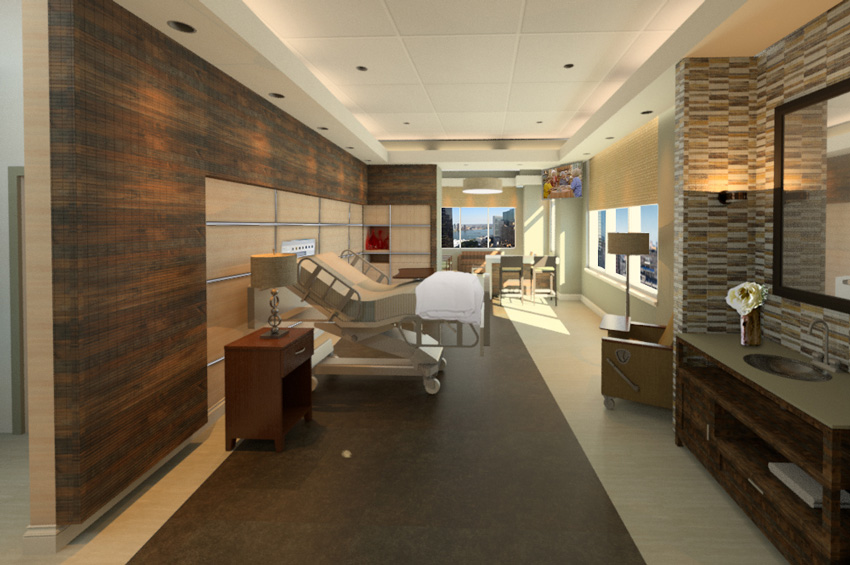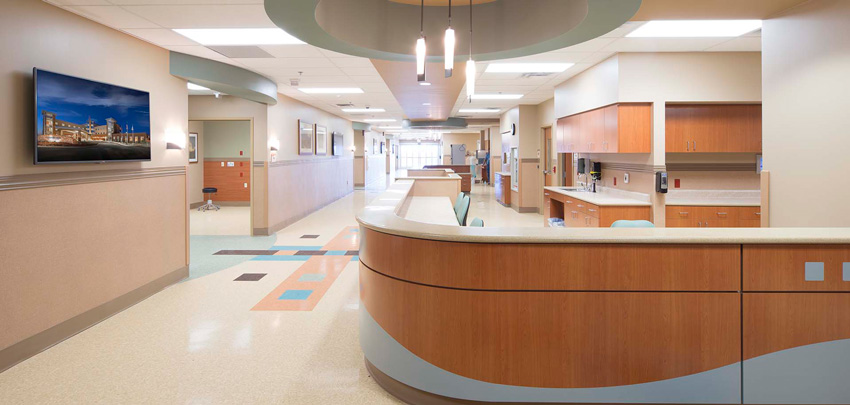Health-Care Surfaces: Marrying Function with Design
How cutting-edge surfacing products create hygiene, durability, and beauty in hospitals, health-care facilities, and pediatrician offices
![]() Continuing Education
Continuing Education
Use the following learning objectives to focus your study while reading this month’s Continuing Education article.
Learning Objectives - After reading this article, you will be able to:
- Examine the challenging environments inside a health-care facility with attention to the need for durability and cleanability as well as advanced antimicrobial qualities.
- Discuss the move away from visually sterile health-care environments toward attractive and comforting design.
- List various stations in a health-care facility and the ideal coordinated surface product specifications for durability, cleanability, harmony, beauty, and microbial resistance.
- Explain testing, standards, and certifications that ensure hard-surfacing products are safe and appropriate for demanding health-care settings.
- Review several case studies that demonstrate various surfaces within health-care facilities that marry form with function.
In every health-care facility, several wars are being waged. First and foremost is the battle against disease, executed by science, medicine, and human efforts. But another battle is simultaneously being waged, and that is a battle between sterility and design. It’s true that a glistening white environment of sterile hard surfaces may look laboratory clean. But such an aesthetic ignores the very real human need for comfort and beauty in the healing process. The antiseptic aesthetic might radiate confidence in the cleanliness of the facility, but such starkness devoid of warmth can cause anxiety in patients, their families, and even the staff. The goal for the designer of a health-care facility should be specification of surface products that fulfill four criteria: cleanability, durability, microbial resistance, and healing aesthetic.

All photos courtesy of Formica Group
In a health-care setting, surfaces need to be cleanable, durable, microbial resistant, and imbued with a healing and calming aesthetic for the patients, their families, and staff.
The Need for Clean Health-Care Environments
It’s easy to see how the quest for sterility could supersede the need for a calming aesthetic. The number of infections acquired by patients in health-care settings has reached alarming rates. These are referred to as health-care-associated infections (HAIs).

Reception counters and other areas in a hospital, clinic, or medical office are touched by multitudes of patients, families, staff, doctors, delivery people, and others throughout the day.
According to the Centers for Disease Control (CDC), on any given day, about one in 20 patients has at least one HAI, and more than 1 million HAIs occur in the health-care industry every year.1 Hospital-acquired HAIs alone are responsible for $28 billion to $33 billion in potentially preventable health-care expenditures annually. Scientific evidence has shown that certain types of HAIs can be drastically reduced to save lives and avoid excess costs.
In 2009, the U.S. Department of Health and Human Services published the HAI Action Plan, also known as the National Action Plan to Prevent Health-Care-Associated Infections: Road Map to Elimination.2
While infections are spread in a number of ways, contaminated surfaces play a part. In end-stage renal facilities, for instance, the HHS report states: “Patients can be at risk of contracting infections from…contaminated surfaces or equipment and from the hands of providers. Infection is the leading cause of morbidity and the second cause of death in patients with chronic kidney failure on hemodialysis.”3
In acute-care hospitals, many infections are due to Clostridium difficile, which causes intestinal distress. The action plan states that because C. difficile spores can persist on environmental surfaces, the role of environmental cleaning is important. The plan calls for several preventative methods, including “develop optimal methods to decontaminate environmental surfaces and water in health-care settings.”
Indeed contaminated surfaces are a major risk factor for HAIs. The word “surface” is mentioned nearly 400 times in the CDC: Guidelines for Environmental Infection Control in Health-Care Facilities: Recommendations of CDC and the Healthcare Infection Control Practices Advisory Committee (HICPAC).4
The HICPAC makes the following suggestion for surfaces, among many others: “Scrubbable materials are preferred for use in patient-care areas.”
Also, a technical brief titled “Cleaning Hospital Room Surfaces to Prevent Health-Care Associated Infections” states: “The cleaning of hard surfaces in hospital rooms is critical for reducing health-care-associated infections.”5
And so when a health-care facility designer or specifier studies the literature to determine best practices for safety, there are literally hundreds or thousands of references to the need for scrubbable, cleanable, sterile surfaces—which might lead to a sterile aesthetic.
Fast-Paced, Challenging Environments
Besides infections, health-care facilities present other challenges for the designer. Consider the traditional hospital hallway or corridor. In a typical day in a busy facility, patients on gurneys might be rushed along the corridor into emergency surgery. Large hospital beds connected to IV stands might be moved along the corridor. Nurses with carts move up and down the hallways. It’s easy to imagine the walls getting bumped into many times a day. Thus, the walls must not only be cleanable but also durable.

Keeping a health-care facility free of infection-causing microbes is of utmost importance. Contamination of surfaces is a major contributor to health-care-associated infections.
And consider the multitudes of people coming in and out of the facility every day, including patients arriving and being discharged, family members and visitors, delivery people, plus doctors, nurses, and other staff members. Each potentially brings into the facility infectious microbes that can linger on any number of surfaces, from the intake counter to the restroom counter.
With all this information about the need for durability and safety in health-care facilities, the designer may tend toward a sterile aesthetic. But there is more to healing than a clean surface. There is the human factor.
A Tone of Serenity Needed in Health-Care Design
A patient’s state of mind, in addition to the wonders of modern medicine, is a critical factor in their return to health.
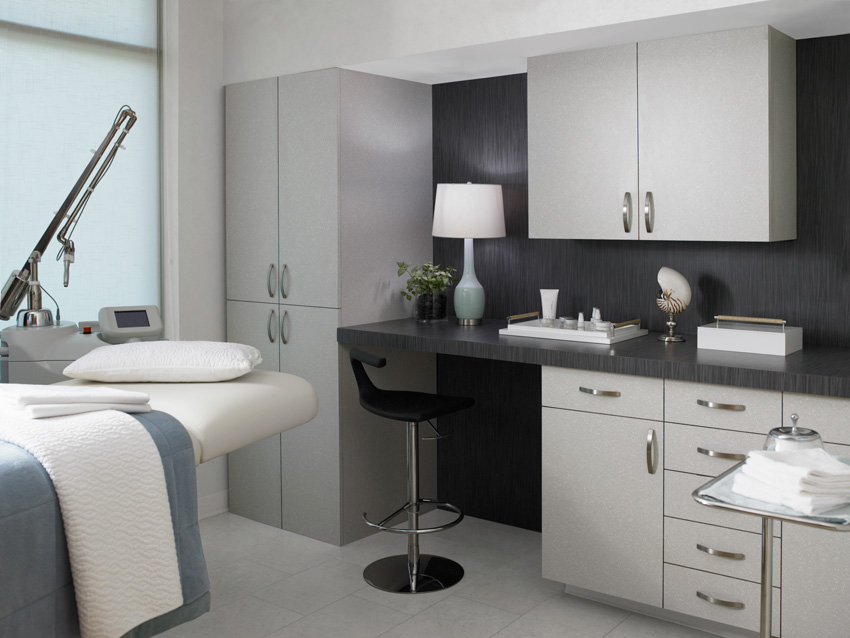
An examination and procedure room filled with calming colors and attractive materials elevates the mood of patients.
News reports have brought the topic of design in health-care settings to the public’s attention. A CNN article titled “Hospital designs that are changing the way you’re cared for” states:
“While the health-care system in America is in a state of crisis, the hospitals, care centers, and research facilities that make up the industry—in the States and abroad—have never looked better. Gone are the days of sterile spaces, shared rooms, and buildings that could be confused for corporate offices. Instead, we’ve seen a new class of hospitals that are more like hotels, with private rooms, gardens, and art installations.”6
Consider the essential role of design in health care. Hospitals are continually striving to take the anxiety and stress out of their environments so patients, families, and staff can focus on care and healing. For architects and designers, this means it’s essential to create a tone of serenity with attention to safety, hygiene, efficiency, and quality. Patient rooms, nurses’ workstations, lobbies, waiting areas, cafeterias, restrooms, and more can be designed to reduce stress through the use of calming colors, antimicrobial surfaces, and soft patterns that support both the patients’ and families’ environments and the hospital’s brand and reputation. With the right specification of surfaces, a health-care design can achieve the perfect balance between utility and beauty.
According to Rebecca Donner, principal at Inner Design Studio in Brentwood, Tennessee, neutral palettes continue to drive design with brighter colors used in accent elements, such as walls.
“Things have really lightened up, and neutrals are popular as they are incredibly timeless,” Donner says, citing color schemes that include cream, beige, and a range of greys as well as lighter wood grains. “Environmental-inspired design continually shows how natural light supports healing, and today’s lighter designs work with this.”
Amy Higgins, director of interior design and associate at HMN Architects, in Overland Park, Kansas, is also using a wide range of warm earth-tone palettes for health-care clients that seek to avoid overly trendy looks and want to remind patients and family members of home.
“Children’s hospitals tend to be very colorful, while adult hospitals are increasingly moving toward a hospitality or spa-like feel,” she says. “When it comes to wood grains, warmer grays are making their way into more spaces as an alternate to brown and yellow hues.”
Regarding material selection, project leaders at hospitals, clinics, and medical office buildings ask about durability, sustainability, and infection control. “Controlling infection is always at the top of the list for hospitals,” Donner stresses. “Environmental services teams need to be able to maintain clean surfaces easily. The surfaces we use have to undergo stringent cleaning, often with bleach.”
Selecting durable, nonporous surfaces for countertops and casework is key to this. Donner noted that in addition to cleanliness, many of her clients are focused on sustainable materials because they know it’s important for the environment and simply “the right thing to do.”
Durability across all elements rings true for Higgins as well. She says that her health-care clients leverage a lot of solid surfaces with antimicrobial properties for high-traffic countertops such as nurses’ stations, reception desks, and patient rooms. With round-the-clock usage, these typically require frequent cleaning and may be exposed to water.
“Our goal is to take a product and make it as durable as we can,” she says, adding that this includes custom casework packages where the firm uses laminates for cabinetry in a variety of spaces, such as waiting areas, public spaces, and patient rooms. “We often work within a value-engineering framework that requires balancing cost with longevity. It’s important that we (designers) and hospital staff make the right material-selection decisions during the project so down the road their surfaces stand the test of time.”
Now that we’ve observed an ideal patient room, let’s look at the areas of a health-care environment that need both superior function and a pleasing aesthetic.
Specifying for Health-Care Facilities: Space by Space
Various spaces in a health-care facility call for different kinds of surfacing materials. Walls need to be extra durable against impacts, while laboratory counters need to resist the growth of microbes. And for intake countertops, fingerprints are a major problem to be solved.
In each case, the solution is likely a high-pressure laminate (HPL) product, or a solid surface product. The functional attributes of each type of product—antimicrobial factors, durability, cleanability, etc.—may not be evident to the casual observer. But variations in colors and patterns from different manufacturers will be disconcerting. Therefore it is advised that surface products used are sourced from one manufacturer, if possible, whose patterns and colors coordinate across various product lines. This is preferable to a scattershot approach to specification from a variety of sources.
What Are High-Pressure Laminates?
It helps to understand what HPLs are and how they are made. HPLs consist of layers of specially selected papers impregnated with thermosetting resins and bonded together under heat and very high pressure. The resulting HPL is a homogeneous, high-density sheet that is used for a wide variety of surfacing applications.
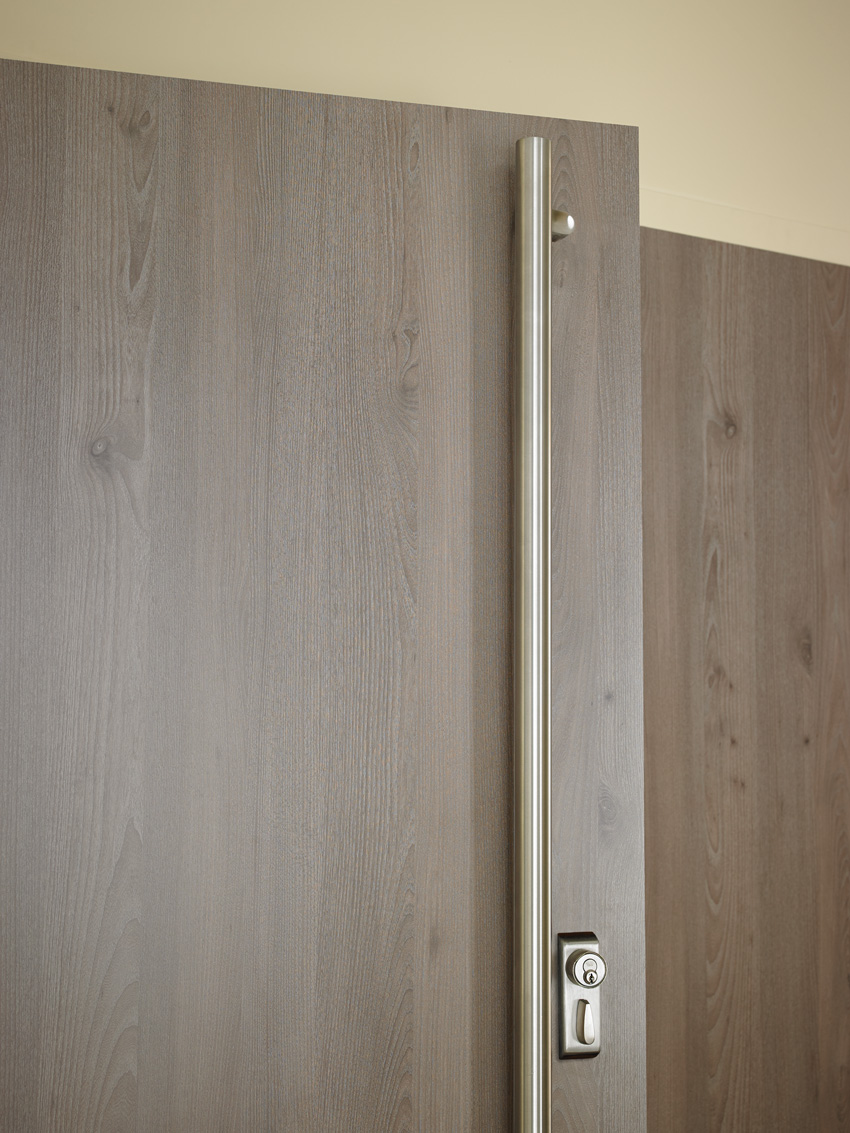
High-pressure laminates are resistant to impact, wear, heat, and staining. They perform well in demanding environments where hygiene and cleanability are important.
HPLs are highly resistant to impact, wear, heat and staining and provide a hygienic, durable, and easily maintained surfacing solution for the most demanding of environments. They can be fabricated to produce curved surfaces which, with their absence of visible seams, will eliminate joints on internal and external angles in which dirt, liquids, mold, bacteria, viruses, and other contaminants can accumulate.
Also, the wide variety of sheet sizes offered enables surfaces to be designed and manufactured with the minimum number of joints or seams. This is especially applicable in environments where a hygienic, cleanable surface with minimal seams and crevices (offering minimal harbor for germs) is desirable.
The inherent physical properties of HPLs help meet the strictest of cleaning and maintenance regimes, without the need for further additives or treatments. Because the surface is completely sealed, quality decorative laminates are impervious to liquids and are very easy to clean and maintain. Laminate surfaces are best kept clean simply by using water and mild detergent. Non-scratch liquids or creams are recommended for stubborn stains.
HPL is inert and does not support microbial growth. As an example, independent testing on a leading manufacturer’s laminate for antimicrobial activity and efficacy demonstrated an inert control surface (no chemical reaction) after 24 hours of incubation for all of the tested organisms: Staphylococcus aureus, Escherichia coli, Candida albicans, and Aspergillus brasiliensis.
Today’s laminates come in vibrant upbeat hues, nature-inspired tones, and well-chosen neutrals that go with everything, including modest budgets. A designer can mix and match solids, wood grains, graphic patterns, or stone looks to achieve a project’s goals.
Laminates come in various grades for various applications. The two most common laminate grades for health-care settings are Grade 12 HGP (horizontal postforming) and Grade 20 VGP (vertical postforming).
Grade 12/HGS (horizontal general purpose) is intended for application to interior horizontal or vertical surfaces where design, appearance, quality, durability, resistance to stain, and resistance to heat from ordinary sources are important considerations.
Grade 20/VGP is intended for application to interior vertical surfaces where design, appearance, quality, durability, resistance to stain, and resistance to heat from ordinary sources are important considerations.
Specification for Walls, Hallways, and Stairways
The challenge: In health-care settings, walls, hallways, and stairways are subject to tremendous contact from people, beds, carts, and gurneys. Unlike a commercial setting such as an office or retail store where the walls are protected by filing cabinets or desks or clothing racks, the walls in a health-care setting are more likely to be exposed to traffic. This helps move patients and equipment quickly from place to place and also creates the ever-important ability to clean and sterilize the surfaces. In an outbreak of infectious disease, for instance, this ability is critical. At the same time, these surfaces that see so much traffic and house patients should embody the designer’s touch for color and style.
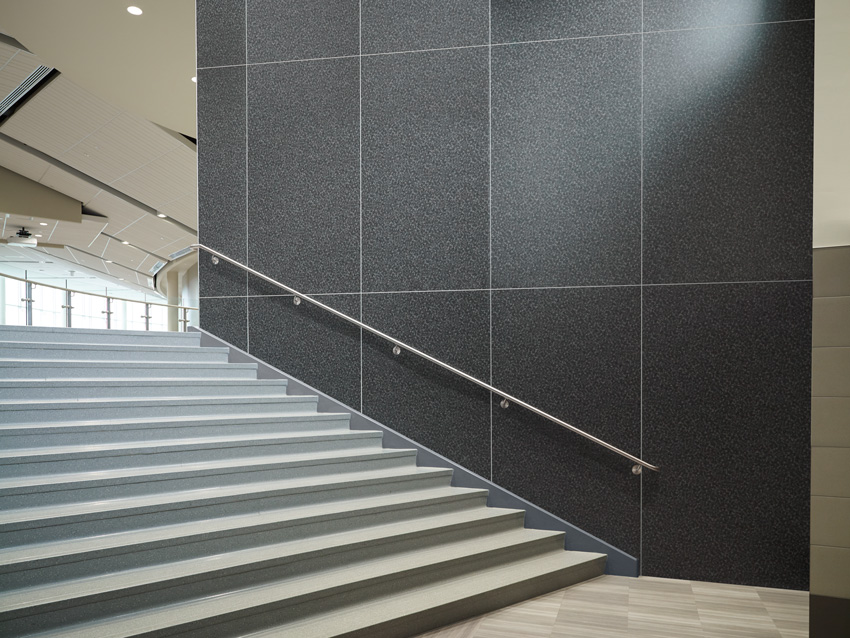
Laminate panels strengthened with fiberglass give walls, hallways, and stairways the durability needed in highly trafficked areas.
The specification: The ideal protection panels for walls and hallways should be extra durable with superior impact resistance. As such facilities are typically renovated every 10 or 20 years, the walls need to be durable enough to withstand years of impacts. Toward that trend, one manufacturer has introduced a new line of fiberglass-reinforced decorative protection panels. The advantage of such a product is that it is available in the manufacturer’s line of color and patterns to seamlessly blend with other types of surfaces in the specification. Such panels are impact and water resistant, easy to install and clean, dimensionally stable, and have a Class A fire rating. Panels such as these can be applied directly to drywall and are suitable for many vertical applications. In addition to health-care settings, fiberglass-reinforced laminates can be specified for restaurants, schools and universities, airports, and elevators.
Counters, Food Environments, and Restrooms
The challenge: A health-care setting, unlike less-complex settings, includes patient rooms, examination rooms, cafeterias, and break rooms, as well as public restrooms and private patient restrooms. These areas call for durable and extremely cleanable surfaces that can be coordinated with the rest of the design aesthetic.

Solid surfacing is a suitable choice for the cafeteria in a health-care setting. When all products can be specified by one manufacturer who offers coordinating colors and patterns, there will be a seamless harmony between different types of products.
The specification: For counters, food areas, and restrooms, solid surfacing is a good choice. Solid surfacing is a solid homogeneous material suitable for many functional and decorative applications. It is a fully densified composite of modified resin and mineral filler. Solid surfacing is an ideal specification for such health-care uses as counters, food environments, and restrooms. It shapes itself to virtually any design concept, and most manufacturers offer palettes of modern colors in every mood. The durable, nonporous surface is also ideal for a worktable or custom bar top as well as sinks and shower surrounds. It is generally available in sheet stock (1⁄4 inch or 1⁄2 inch) and formed into sinks and vanity bowls.
Registration Counters
The challenge: Long before any medical staff can diagnose or treat a disease or infection, the person carrying it will likely begin his or her health-care journey at the registration counter. Patient after patient will be using and touching the counter hour after hour. To protect other patients, their families, and the staff, the registration counter will need to be kept clean and sterile. But being at the registration counter should also be a pleasing experience to get the health-care process off to a calming and harmonious start.

The ideal reception counter will be cleanable, resist fingerprints, and have antimicrobial qualities.
The specification: As the first surface a patient interacts with, the ideal material for a registration counter should be both beautiful and durable, perhaps with a soft-to-the-touch super matte finish that resists fingerprints. The most ideal product would have built-in antimicrobial surface protection, a technology that stops the growth of mildew and mold, which can cause stains and odors. In addition to health-care settings, this type of surfacing is also suitable for high-traffic areas such as cafes, diners and quick-service restaurants, hotels and retail, commercial offices, or any setting that calls for countertops, tables, doors, partitions, cabinets, and furniture.
Labs and Operating Rooms
The challenge: Of all the surfaces in a health-care setting, the lab and operating rooms are subject to the most chemicals and other liquid and solid materials. Consider the typical laboratory chemicals and reagents that were used to test a leading manufacturer’s most chemical-resistant laminate sheets. They include acetic acid, formaldehyde, hydrogen peroxide, sulfuric acid, zinc oxide, and more. To achieve certification from the Scientific Equipment and Furniture Association for use in labs, products are tested for exposure to 49 harsh chemicals.

Laboratory and operating room surfaces are subject to a multitude of harsh chemicals. Rigorous testing ensures these surfaces can hold up to such chemicals without damage.
The specification: For such a challenging environment where surfaces are exposed to chemicals, abrasive materials, and other surface stresses, a chemically resistant laminate is absolutely critical. This product typically is available in laminate sheets intended for application to interior horizontal and vertical surfaces where design, appearance, quality, durability, and resistance to relatively harsh acids, alkalis, corrosive salts, and other destructive or staining substances are required.
Horizontal surfaces include sinks, counters, lab benches, tabletops, and other work surfaces in chemical, medical, and scientific settings, pathogenic laboratories, clinics, photographic laboratories, mortuaries, nursing stations, and other institutional uses, as well as commercial or light-duty manufacturing operations.
Vertical surfaces where a chemically resistant surface is advised include cabinets, casework fronts, wall backsplash panels, and screens. Also recommended are laminate sheets that are available in a postformable grade and can be postformed around an outside radius and an inside cove radius. Postforming provides an ergonomic edge and protection against chemicals attacking a fabricated seam.
Patient Rooms and Nurses Stations
The challenge: Communication is key for a smoothly operating health-care facility. With nurses on different shifts moving in and out of patients’ rooms, and with doctors coming and going on their rounds, a highly visible method of communication can go a long way to cut down on mistakes and miscommunications.
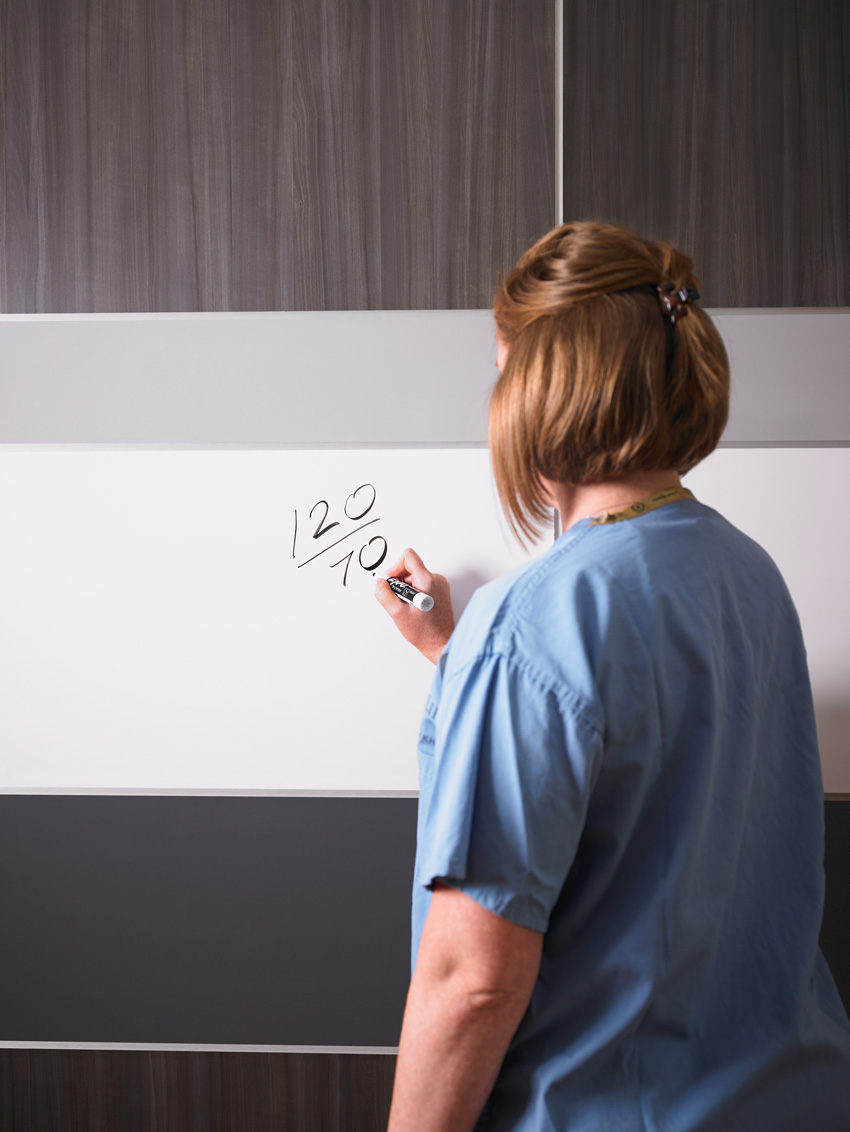
Because miscommunication can lead to medical errors, added methods of communication are highly valued in a health-care setting. A magnetic whiteboard serves that function.
The specification: One way to facilitate communication and expression is specification of a magnetic laminate surface. This is an HPL with an iron foil incorporated under the surface décor and has a gloss finish. The iron foil gives the laminate its magnetic qualities. Magnetic laminates in gloss finish are especially suitable for use as marker boards or writing surfaces not only for nurses’ stations and patient rooms but also in education, office, and commercial environments. Text and images can be drawn onto the surface using a good-quality dry-erase marker and can be removed using a felt-based eraser. Depending on the quality of the markers, no ghosting should occur; however, if ghosting does occur, it can be removed by using whiteboard cleaning foam. Some laminate marker board products have grid points to provide a precision guide for writing or drawing. A product specified with a matte finish can be used as projection screen.
Pediatrician Offices and Children’s Hospitals
The challenge: Visiting a health-care facility is disconcerting enough for adults to handle and even more frightening for children. All attempts are made to create not only a safe and durable environment but also a happy and high-spirited space. The designer may have a color combination in mind to match a branding goal or wish to design something completely different and distinctive.
The specification: For a pediatrician’s office or children’s hospital where a cheerful and colorful aesthetic is absolutely necessary, a custom laminate product might be the best specification. For a designer, the possibility of creating a surface that is a unique piece of art on high-performance laminate is an appealing idea. This can be achieved using a design, photography, logo, illustration, or painting. The process involves melamine-impregnated decorative surface papers combined with phenolic-treated kraft paper and consolidated in a press at high pressures. The sheet back is sanded to maintain a uniform thickness and facilitate bonding.
Design Ideas for Health-Care Facilities
The need for clean, long-lasting surfaces in health care dictates several important design requirements as designers select and install surfaces.
Color: Neutral palettes that incorporate a calming blend of warm and cool colors are pleasing to the eye. Adding an occasional pop of color brings interest to cafeterias, gift shops, waiting areas, and pediatrics floors where subtle brights help establish a creative, welcoming environment.
Texture: Patterns that mimic natural elements like linen, stone, wood, plants, and even leather bring thoughts of home or hospitality settings. Textures reminiscent of the area, including mountains, deserts, water, and grasses, can be subtly mimicked in furniture and accent surfaces.
Visual diversity: Distraction from the events of the day is important in health care. Color and texture both play a role in this when it comes to visual diversity. This concept uses points of intrigue to give waiting family members or patients receiving treatments such as chemotherapy something interesting to observe. This can be achieved by blending woods, incorporating textured vertical surfaces for walls and doors, bringing in interesting colors, and highlighting local artwork.
Testing Standards and Certifications
For such high-functioning surfaces, which are required in a health-care setting, products must undergo rigorous testing, and achieve standards and certifications to ensure hard-surfacing products are safe and appropriate. Here is a sampling of some tests.
ASTM
Testing goal: Fungal resistance
Test: ASTM G21: Standard Practice for Determining Resistance of Synthetic Polymeric Materials to Fungi
According to ASTM: “The synthetic polymer portion of these materials is usually fungus resistant in that it does not serve as a carbon source for the growth of fungi. It is generally the other components, such as plasticizers, cellulosics, lubricants, stabilizers, and colorants, that are responsible for fungus attack on plastic materials.”8 For best results when fungal resistance is desired, consider a product that has passed this test.
Testing goal: Antibacterial
Test: JIS Z 2801/ISO 22196: Measurement of Antibacterial Activity on Plastics Surfaces and Other Nonporous Surfaces
This test method is designed to quantitatively test the ability of hard surfaces to inhibit the growth of microorganisms or kill them over a 24-hour period of contact. In this test method, according to one lab, “A bacterial suspension is applied to the test specimen and control pieces, in triplicate. Microorganism inoculated test pieces are then covered with a sterile thin membrane to spread the inoculum, avoid dehydration, and promote good contact between antimicrobial surface and the test organism. Samples are then incubated for 24 hours. Microbial counts are determined before and after incubation. Reduction of microorganisms is then calculated by using initial count and surviving microorganisms.”9
Scientific Equipment and Furniture Association (SEFA)
A product that is SEFA approved resists harsh chemicals. SEFA’s mission is to promote the use of laboratory-grade furniture, equipment, and fixtures. Manufacturers who want to have their products tested and proven compliant with SEFA’s Recommended Practices do so through one of 18 nationwide SEFA-approved independent third-party labs. For best results when resistance to harsh chemicals is desired, choose a product that is SEFA approved.
National Sanitation Foundation (NSF)
A product that meets the NSF Standard 35 is approved for food-contact surfaces. This standard establishes minimum sanitation requirements for the materials and fabrication of HPLs. For best results when the product will be used in food areas, choose a product that meets this standard.
Greenguard
Greenguard Gold Certified products meet strict chemical emissions limits, which contributes to the creation of healthier interiors. According to the organization, “Greenguard Gold Certification (formerly known as Greenguard Children & Schools Certification) offers stricter certification criteria, considers safety factors to account for sensitive individuals (such as children and the elderly), and ensures that a product is acceptable for use in environments such as schools and health-care facilities. It is referenced by both The Collaborative for High-Performance Schools (CHPS) and the Leadership in Energy and Environmental Design (LEED) Building Rating System.”10
Conclusion
Because of the numerous incidents of HAIs, cleanliness is arguably the most critical feature in a health-care setting. Surfaces and features must be cleanable and, if possible, resistant to bacteria, fungi, and other contaminants. Surfaces must additionally be durable in a very demanding environment. However, the surfaces specified for a health-care setting should also be soothing and calming for patients, their families, and the staff. A pleasant environment is also a critical factor in the overall goal of health care: to return the patient to wellness. Toward that end, architects and designers who specify products for a health-care facility will want to choose products that are not only tested and proven for the needs of each area in a setting but also aesthetically pleasing and harmonious. Rather than specifying products from a variety of disparate sources, the designer should choose high-performing surfaces within one manufacturer’s catalog to ensure the harmony between products that support the program: an environment that is clean, safe, durable, and beautiful.
End Notes
1“Guidelines for Environmental Infection Control in Health-Care Facilities: Recommendations of CDC and the Healthcare Infection Control Practices Advisory Committee (HICPAC).” U.S. Department of Health and Human Services. Centers for Disease Control and Prevention. 2003. Web. 4 January 2019.
2“National Action Plan to Prevent Health-Care-Associated Infections: Road Map to Elimination.” Office of Disease Prevention and Health Promotion. U.S. Department of Health and Human Services. Web. 4 January 2019.
3Part 1: Executive Summary, Metrics, and Goals. “National Action Plan to Prevent Health-care-Associated Infections: Road Map to Elimination.” Office of Disease Prevention and Health Promotion. U.S. Department of Health and Human Services. April 2003. Web. 4 January 2019.
4 “Guidelines for Environmental Infection Control in Health-Care Facilities: Recommendations of CDC and the Healthcare Infection Control Practices Advisory Committee (HICPAC).” U.S. Department of Health and Human Services. Centers for Disease Control and Prevention. 2003. Web. 4 January 2019.
5Han, Jennifer et al. “Cleaning Hospital Room Surfaces to Prevent Health-Care-Associated Infections: A Technical Brief.” Annals of Internal Medicine. American College of Physicians. Web. 4 January 2019.
6Stamp, Elizabeth and Alleyene, Allyssia. “Hospital designs that are changing the way you’re cared for.” CNN Style. 20 June 2017. Web. 4 January 2019.
7“Street artist Okuda San Miguel leaves his Younique mark on San Carlos Hospital.” Formica. Web. 4 January 2019.
8“ASTM G21 – 15: Standard Practice for Determining Resistance of Synthetic Polymeric Materials to Fungus.” ASTM International. Web. 4 January 2019.
9“Summary of ISO 22196 Test Method.” Accugen Labs. Web. 4 January 2019.
10“Greengold Gold Certification.” UL Environment. Web. 4 January 2019.
11“Canyon Vista Medical Center.” Gould Turner Group. Web. 4 January 2019. Kathy Price-Robinson is an award-winning housing and construction writer. Her series on home remodeling ran 12 years in the Los Angeles Times. She has profiled more than 500 projects and developed more than 100 continuing education courses. www.linkedin.com/in/kathypricerobinson

